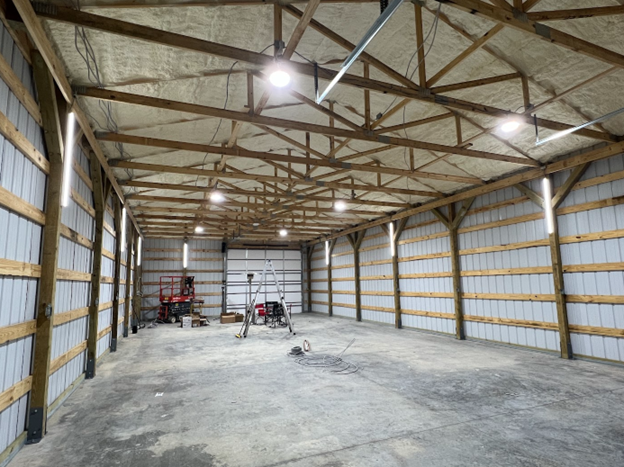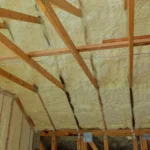Barn operators who need fast, stable temperature control now turn to Spray Foam Insulation because it seals gaps, blocks moisture and delivers the highest practical R‑value in a single application. In a typical livestock barn, installing closed‑cell foam along walls and under the roof can cut heat loss by 40–60 % and slash summertime heat gain, keeping animals within their comfort zone year‑round. Energy‑use studies show payback often falls under three heating seasons—even in metal‑clad sheds where drafts once felt inevitable.
Beyond direct energy savings, foam’s seamless air barrier throttles moisture and ammonia migration, lowering disease pressure and protecting feed, fans and electrical gear. When applied by a qualified crew, the cured material bonds to steel, wood, CMU and concrete, so there is nothing left loose for livestock to chew or dislodge.
Key Performance Factors
Airtightness and Thermal Resistance
- R‑Value per inch: Closed‑cell reaches R‑6.7 – R‑7.4; open‑cell averages R‑3.6.
- Continuous seal: Foam expands 30–120 × its liquid volume, filling nail holes, lap seams and fastener shadows in corrugated metal.
Bonus Tip #1
Apply foam down into the kick board region to cut drafts at animal level—often overlooked when only wall cavities are sprayed.
Moisture Management
Closed‑cell foam’s < 1 perm rating turns the barn shell into a vapor retarder, preventing condensation on metal sheets during cold snaps. Integrated water shedding drastically reduces mold on hay and bedding.
Durability and Animal Comfort
Cured foam withstands high‑pressure washing and the occasional hoof strike. By smoothing interior surfaces, it reduces roosting spots for birds and provides a quieter environment—benefits proven to lower stress in dairy herds.
Spray Foam Types and Specifications

Technical Data
| Property | Closed‑Cell Foam | Open‑Cell Foam |
| Core Density (lb/ft³) | 2.0 ± 0.2 | 0.5 ± 0.2 |
| R‑Value (per in) | 6.7 – 7.4 | 3.5 – 3.8 |
| Water Vapor Permeance* | < 1 perm | 12 – 16 perm |
| Compressive Strength | 25–30 psi | 4 – 6 psi |
| Airtight Thickness | 1.5 in | 3.5 in |
| Typical Barn Use | Roof deck, exterior walls, concrete stem walls | Partition walls, sound control |
*ASTM E96 Procedure A.
Comparison: Foam vs Traditional Options
| Criterion | Spray Foam Insulation | Fiberglass Batts | Rigid PIR Board |
| Installation Time | 1 day / 5,000 ft² | 2–3 days | 2 days |
| Thermal Bridging | None | High (stud lines) | Moderate |
| Air Seal Quality | Integral | Requires wrap | Requires taped joints |
| Rodent Damage Risk | Very low | Moderate to high | Low |
| Average Installed Cost (USD/ft²) | $1.80 – $2.50 | $1.20 – $1.60 | $2.30 – $2.80 |
| Typical Barn Humidity Control | Excellent | Poor | Good |

Bonus Tip #2
In cold continental zones, combine 2 in closed‑cell foam with a 2 in blown‑in cellulose cap (the “flash‑and‑fill” method) to reach higher R‑values without overspray risk near wiring.
Integrated Market Facts
- The global spray foam market stood at USD 2.4 billion in 2023 and is growing at 6.2 % CAGR (2024‑2032), driven largely by building‑energy mandates.
- Agricultural insulation materials, including foam, reached USD 2.83 billion in 2024 and are set to climb to USD 4.36 billion by 2033 as farms modernize climate‑controlled housing.
Working With a Spray Foam Insulation Company
- Scope walk‑through – Specialists measure surface area, check ventilation clearances and flag sensitive equipment.
- Substrate prep – Dust removal, tack welding of metal panels and masking of water lines.
- Application – Two‑component foam sprayed in passes (½ in lifts for closed‑cell).
- Quality checks – Core samples confirm density and adhesion; thermal imaging verifies coverage.
Bonus Tip #3
Schedule spraying after electrical rough‑in but before installing pen fixtures to keep bays clear and speed crew movement.
Things to Consider Before Making a Decision
- Barn function – Dairy, hog, poultry and seed‑storage barns have different humidity ranges; pick foam type accordingly.
- Climate severity – More than 6,000 heating degree‑days? Closed‑cell pays back faster.
- Ventilation strategy – Ensure controlled fresh‑air flow once the shell becomes airtight.
- Fire code – Many jurisdictions require an intumescent coating over exposed foam in occupied spaces.
- Future retrofits – Plan chaseways before foam makes walls inaccessible.
- Expertise – Verify the spray foam insulation company carries SPFA Professional Certification for ag structures.
Common Questions
Can foam trap moisture in wooden framing?
Only if the foam is applied to actively wet wood. To avoid this, use a moisture meter to ensure levels are below 15% before application begins.
Will animals chew the cured foam?
The cured spray foam forms a hard surface with added deterrents that most livestock avoid. However, areas around feeding zones may benefit from extra protection like kick plates.
Does foam off-gas long-term?
No, the off-gassing process completes within 24 hours. After that, the foam is inert, and barns can be safely reoccupied once ventilated.
Are professionals required, or can staff apply spray foam kits?
Due to the scale and precision required, large-scale barn applications should only be handled by spray foam insulation contractors or trained professionals using high-output equipment.
Is spray foam suitable for metal barns?
Yes, especially closed cell spray foam, which adheres well to corrugated metal, seals fastener gaps, and prevents condensation on steel surfaces.
FAQ
Q1. How thick should spray foam be in a livestock barn?
Closed‑cell: 2 in (walls) and 3 in (roof) cover most climates. Open‑cell: 5½ in for walls, 7 in for roof.
Q2. Can I retrofit over existing fiberglass?
Yes—foam can be sprayed directly onto clean batts, sealing edges and boosting air control.
Q3. Will foam reduce fan‑powered ventilation rates?
No; it lowers unwanted infiltration, allowing fans to deliver precise air exchanges.
Q4. How long does application take on a 10,000 ft² barn?
Typically two days: one for masking and spraying, one for cure, trim and clean‑up.
Q5. What is the service life of barn‑grade spray foam?
Tests show closed‑cell retain over 90% R‑value after 25 years. Many barns still operate with foam insulation installed 30 years ago.
Conclusion
Spray Foam Insulation delivers the fastest, most durable path to stable barn climates by combining high R‑value, an integral vapor barrier and exceptional adhesion in one trade. Evaluate foam type, ventilation and installer competence against your herd’s comfort targets and local energy costs; in most cases the numbers favor closed‑cell foam applied by seasoned agricultural specialists.
Reviewer: With 11 years in the spray foam field, Aiden Baker reviewed this content and provided advice on building steady growth through practical, honest communication.

